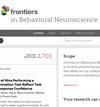血清素驱动半自然环境中实验雄鼠的攻击和社会行为
IF 2.6
3区 医学
Q2 BEHAVIORAL SCIENCES
引用次数: 0
摘要
攻击是一种适应性社会行为,对社会群体的稳定和繁荣至关重要。一旦失控,攻击行为就会导致病态暴力,破坏群体结构和个人福祉。在不同的精神病理学中,不受控制的攻击行为具有共存性,这使其成为具有相同神经生物学基质的精神疾病的潜在内表型。血清素在调节冲动和攻击行为方面起着至关重要的作用。色氨酸羟化酶 2(TPH2)是血清素合成过程中的限速酶,由于色氨酸羟化酶 2 的缺失,脑血清素缺乏的小鼠可作为研究病理性攻击行为的潜在模型。通过家笼监测可以持续观察和量化群居、自由活动的小鼠的社会和非社会行为。我们采用一种伦理学方法,研究了中枢羟色胺消减对不受干扰、群居的Tph2缺陷型小鼠和野生型小鼠日常社交和非社交行为表现的影响及其相关性。通过对行为时间序列进行机器学习算法训练,"异性梳理"、"在喂食器前挣扎 "和 "进食 "成为区分一种基因型和另一种基因型的关键行为。虽然与野生型小鼠相比,Tph2缺陷型小鼠表现出病理性攻击和交流减少的特征,但它们仍然表现出正常水平的隶属抱团行为。总之,Tph2缺陷小鼠这种独特而动态的表型影响了群体的结构及其随后的等级组织发展。我们使用社会网络分析和格利科评分法对这些方面进行了分析。这项研究表明,在了解病态攻击对个体和群体生活各方面的全面影响时,采用伦理学方法非常重要。家笼监测可以观察小鼠在半自然栖息地的自然行为,从而准确反映真实世界的现象和病理机制。这项研究的结果有助于深入了解病理性攻击行为的神经生物学基础及其在复杂脑部疾病中的潜在作用。本文章由计算机程序翻译,如有差异,请以英文原文为准。
Serotonin drives aggression and social behaviors of laboratory male mice in a semi-natural environment
Aggression is an adaptive social behavior crucial for the stability and prosperity of social groups. When uncontrolled, aggression leads to pathological violence that disrupts group structure and individual wellbeing. The comorbidity of uncontrolled aggression across different psychopathologies makes it a potential endophenotype of mental disorders with the same neurobiological substrates. Serotonin plays a critical role in regulating impulsive and aggressive behaviors. Mice lacking in brain serotonin, due to the ablation of tryptophan hydroxylase 2 (TPH2), the rate-limiting enzyme in serotonin synthesis, could serve as a potential model for studying pathological aggression. Home cage monitoring allows for the continuous observation and quantification of social and non-social behaviors in group-housed, freely-moving mice. Using an ethological approach, we investigated the impact of central serotonin ablation on the everyday expression of social and non-social behaviors and their correlations in undisturbed, group-living Tph2 -deficient and wildtype mice. By training a machine learning algorithm on behavioral time series, “allogrooming”, “struggling at feeder”, and “eating” emerged as key behaviors dissociating one genotype from the other. Although Tph2 -deficient mice exhibited characteristics of pathological aggression and reduced communication compared to wildtype animals, they still demonstrated affiliative huddle behaviors to normal levels. Altogether, such a distinct and dynamic phenotype of Tph2 -deficient mice influenced the group's structure and the subsequent development of its hierarchical organization. These aspects were analyzed using social network analysis and the Glicko rating methods. This study demonstrates the importance of the ethological approach for understanding the global impact of pathological aggression on various aspects of life, both at the individual and group levels. Home cage monitoring allows the observation of the natural behaviors of mice in a semi-natural habitat, providing an accurate representation of real-world phenomena and pathological mechanisms. The results of this study provide insights into the neurobiological substrate of pathological aggression and its potential role in complex brain disorders.
求助全文
通过发布文献求助,成功后即可免费获取论文全文。
去求助
来源期刊

Frontiers in Behavioral Neuroscience
BEHAVIORAL SCIENCES-NEUROSCIENCES
CiteScore
4.70
自引率
3.30%
发文量
506
审稿时长
6-12 weeks
期刊介绍:
Frontiers in Behavioral Neuroscience is a leading journal in its field, publishing rigorously peer-reviewed research that advances our understanding of the neural mechanisms underlying behavior. Field Chief Editor Nuno Sousa at the Instituto de Pesquisa em Ciências da Vida e da Saúde (ICVS) is supported by an outstanding Editorial Board of international experts. This multidisciplinary open-access journal is at the forefront of disseminating and communicating scientific knowledge and impactful discoveries to researchers, academics, clinicians and the public worldwide.
This journal publishes major insights into the neural mechanisms of animal and human behavior, and welcomes articles studying the interplay between behavior and its neurobiological basis at all levels: from molecular biology and genetics, to morphological, biochemical, neurochemical, electrophysiological, neuroendocrine, pharmacological, and neuroimaging studies.
 求助内容:
求助内容: 应助结果提醒方式:
应助结果提醒方式:


